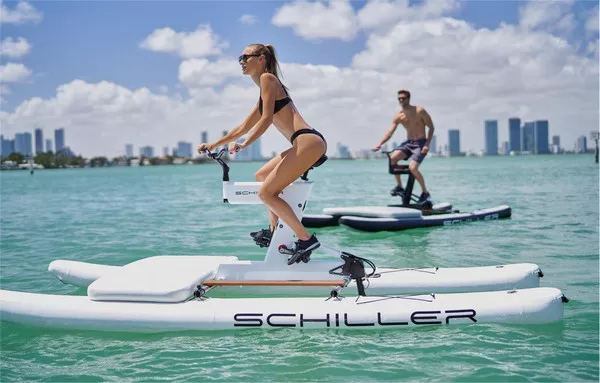Water biking, a thrilling aquatic adventure that combines the joy of cycling with the serenity of being on the water, has gained significant popularity in recent years. Whether you’re a fitness enthusiast seeking a new challenge or a nature lover longing for unique experiences, water biking offers a refreshing way to explore waterways while staying active. In this comprehensive guide, we’ll delve into everything you need to know to get started with water biking, from equipment essentials to safety tips and technique pointers.
Getting Started: Essential Equipment
Before embarking on your water biking journey, it’s crucial to ensure you have the right equipment to stay safe and make the most of your experience. Here’s a breakdown of the essential gear you’ll need:
1. Water Bike: The centerpiece of your adventure, a water bike resembles a traditional bicycle but is equipped with pontoons or hydrofoils that provide buoyancy and stability on the water. When selecting a water bike, consider factors such as weight capacity, maneuverability, and ease of assembly for transportation.
2. Personal Flotation Device (PFD): Safety should always come first when engaging in water activities. A properly fitted PFD is essential for all water bikers, providing buoyancy and peace of mind in case of an unexpected fall into the water.
3. Paddle: Most water bikes come with paddles specifically designed for aquatic use. Opt for lightweight, durable paddles with ergonomic grips to ensure comfortable and efficient propulsion.
4. Safety Whistle and Signal Devices: These compact tools can be lifesavers in emergency situations, allowing you to attract attention and communicate distress signals to nearby boaters or rescuers.
5. Sun Protection: Spending hours on the water exposes you to the sun’s harmful rays. Don’t forget to pack sunscreen, sunglasses, and a wide-brimmed hat to shield yourself from UV damage and minimize the risk of sunburn.
Safety First: Tips for a Secure Adventure
While water biking is a thrilling activity, it’s essential to prioritize safety to prevent accidents and ensure a memorable experience. Follow these safety tips before hitting the water:
1. Check Weather Conditions: Before heading out, familiarize yourself with the weather forecast and water conditions for your chosen location. Avoid biking in strong winds, thunderstorms, or rough waters, as these conditions can pose significant risks.
2. Wear Your PFD: Always wear your personal flotation device while water biking, regardless of your swimming ability. In the event of a fall or capsize, a PFD can keep you afloat and increase your chances of rescue.
3. Stay Hydrated: Spending time in the sun and engaging in physical activity can lead to dehydration. Bring an ample supply of water and stay hydrated throughout your water biking excursion.
4. Mind Your Surroundings: Be mindful of other watercraft, swimmers, and wildlife in the area. Maintain a safe distance from obstacles such as rocks, buoys, and piers to avoid collisions and potential injuries.
5. Know Your Limits: Water biking can be physically demanding, especially in choppy waters or strong currents. Listen to your body and avoid pushing yourself beyond your limits to prevent exhaustion or injury.
Mastering Technique: Tips for Efficient Cycling
While water biking shares similarities with traditional cycling, mastering the technique requires adjustments to accommodate the aquatic environment. Follow these tips to enhance your efficiency and enjoyment while on the water:
1. Maintain Proper Posture: Sit upright on your water bike with your back straight and shoulders relaxed. Engage your core muscles to stabilize your body and maintain balance as you pedal.
2. Focus on Smooth Pedaling: Unlike cycling on land, water biking involves pedaling against the resistance of water. Aim for a smooth, consistent pedaling rhythm to maximize propulsion and minimize energy expenditure.
3. Use Your Core Muscles: Your core muscles play a crucial role in maintaining stability and generating power while water biking. Focus on engaging your core with each pedal stroke to enhance your balance and efficiency.
4. Navigate with Confidence: As you gain experience, experiment with steering and maneuvering your water bike to navigate different water conditions with ease. Practice turning, stopping, and reversing to build confidence and control.
5. Embrace the Experience: Above all, embrace the unique experience of water biking and enjoy the sights and sounds of your aquatic surroundings. Whether you’re exploring serene lakes, meandering rivers, or coastal waterways, let the beauty of nature inspire and invigorate your adventure.
Conclusion
Water biking offers a thrilling blend of fitness, adventure, and natural beauty, making it a must-try activity for outdoor enthusiasts of all ages. By equipping yourself with the right gear, prioritizing safety, and honing your technique, you can embark on unforgettable water biking adventures and create lasting memories on the water. So, grab your paddle, don your PFD, and dive into the adventure of water biking today!

